As someone who has struggled with persistent sinus congestion due to recurrent viral and cold encounters, I’ve explored numerous remedies beyond the typical doctor’s prescription of antibiotics, which, in my experience, often led to recurring issues, particularly when fungal overgrowth was involved. I want to share the steps that have worked for me personally and some of the best remedies for sinus infection that I personally used and helped.

Understanding The Source of Congestion
First of all it’s essential to understand the source of your congestion. Nasal congestion is commonly caused by two broad categories of factors:
- External Factors: Environmental triggers such as allergens (pollen, dust), irritants (smoke, pollution, dry air), and pathogen exposure (viruses causing cold or flu).
- Internal Factors: These involve physiological issues like sinus infections (bacterial or fungal, which follow after a cold or flu), nasal polyps, deviated septum, hormonal changes, and reactions to certain medications.
When it comes to chronic sinus infections (rhinosinusitis), it is a complex condition caused by various factors combined. While infections are suspected (and many times caused by biofilms), it’s often the body’s abnormal immune response that leads to long-term inflammation. It may be caused by dysregulated innate immunity, which disrupt the balance in our nasal lining and cause immune overreaction. This leads to continuous inflammation, even without triggers.
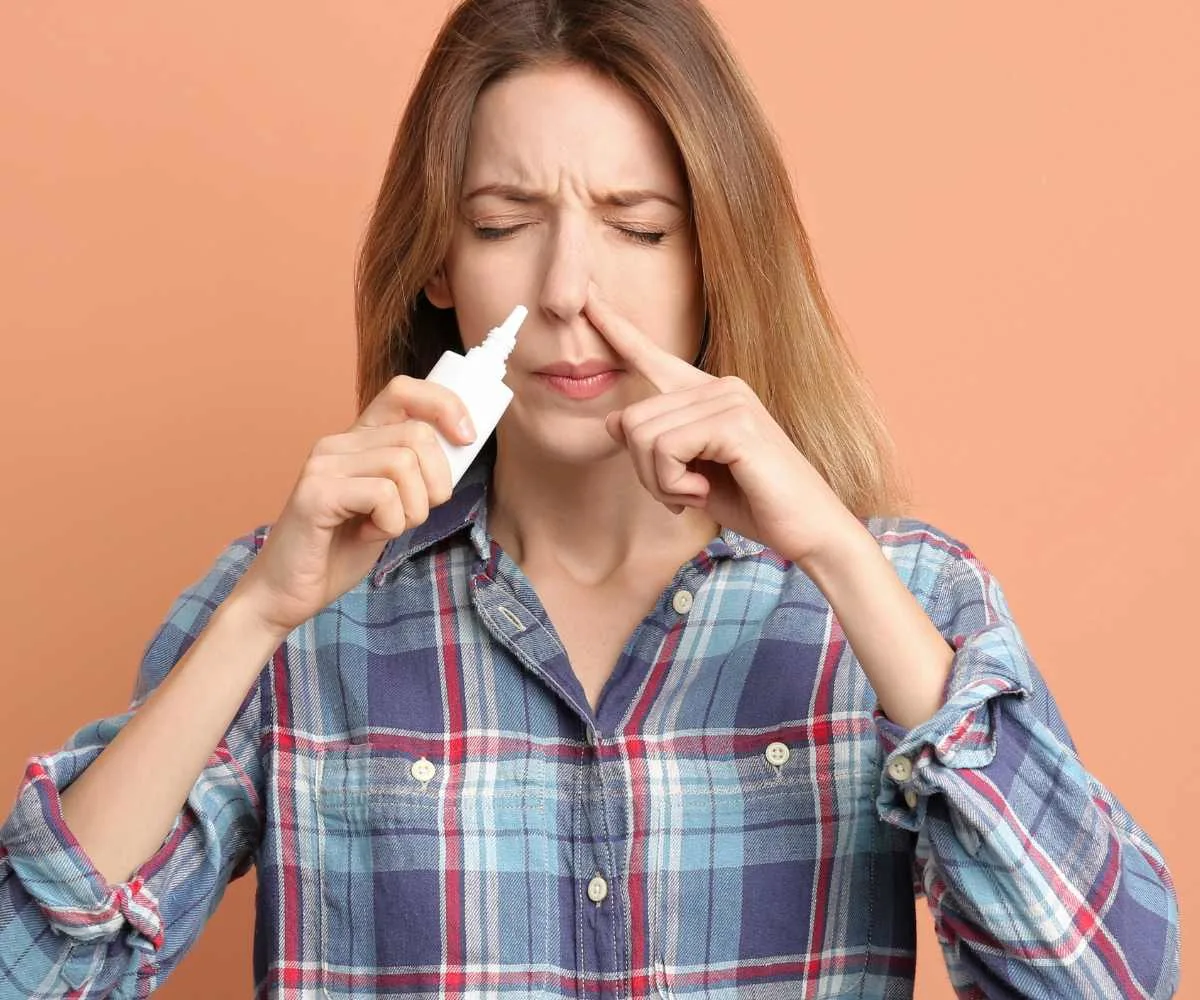
The remedies that I’m talking about in this post as natural decongestants, are effective for congestions that are not caused by physiological deformities, like nasal polyps, or a deviated septum. So make sure to get a proper diagnose first with a specialist assistance.
My Top Natural Decongestants for Sinus Relief (Step-by-Step)
In order for these natural decongesting remedies to work you need to perform them in the following order. First you reduce inflammation to open up the sinuses, then thin out the mucus in order to drain it easier, and then you flush it out. Otherwise, the congested mucus may remain too thick and stuck, making it difficult to clear the sinuses effectively, leading to a full-blown sinus infection.
Step 1: Reducing Inflammation and Opening Sinuses
Inflammation is a key factor in sinus congestion. To address this, I turned to natural remedies, although in severe cases, I resorted to NSAIDs like ibuprofen temporarily. Once you reduce the inflammation its easier for these natural decongestants to work. Here are the best ways to open up the sinuses naturally:
Heads up: some links are affiliated & I may receive a small commission from qualifying sales. For more info see my disclaimer policy.
- Steam Inhalation: Using dry herbs like thyme, mint or chamomile in a facial steamer for at least 20 minutes twice a day. The addition of antibacterial and anti-inflammatory herbs is more effecttive than just using plain water. The steam helps open up the nasal passages, thin out the mucus and relief the pain ssociated with sinus congestion. Tip: make sure to to cleanse the nasal cavity (with a saline spray or rinse) before and after inhalation to cleanse the nasal passage as much as possible.

- Hot Foot Baths: Keeping feet in hot water for at least 20 minutes about as hot as the person can tolerate. The feet should become quite red while in the tub. Immersing my feet in hot water to induce sweating, helped open the sinus canals by pulling excess blood from the congested part, and increasing the blood circulation. Once the sinuses open up then you can do a saline rinse.
- Essential Oils: Massaging the sinuses with anti-inflammatory oils like frankincense, myrrh, fir needle or pine oil, sage, and chamomile essential oil provides relief. These are gentle kid safe oils that can be used on skin (dilluted). As carrier oil I used castor oil. I massaged the painful area at least 30 minutes before doing a nasal rinse or before bed.
Note: For general use, a safe dilution ratio is 2-3% essential oil in a carrier oil. This translates to about 12-18 drops of essential oil per ounce (30 ml) of carrier oil.
- Pressure Points: Applying pressure to specific points in the eyesocket area between eyebrows and pressure to the suboccipital muscle area in the neck, right behind the base of the skull, helped open airways and relieve pain (see pictures). See more sinus massage videos for a clearer understanding. You can do this while sitting in a hot bathtub before preparing for a sinus rinse.

- Supplements: Liver cod oil, turmeric, bromelain and quercetin are scientifically proven to be beneficial for managing inflammation. You can take one or two types of supplements and see what works for you. Consult with a doctor if you’re not sure.
Step 2: Use Mucolytic Agents to Thin Out Mucus
Thinning the mucus is crucial for easing congestion especially when you’re dealing with thick, sticky mucus. And for an effective sinus rinse you need to unclog your sinuses first. Here are some natural mucus thinners and decongestants:
- NAC (Acetylcysteine): Backed by studies, this proved effective in breaking up mucus and not only. In addition to its mucus-thinning properties, NAC also possesses anti-inflammatory effects and also was found to be effective in disrupting biofilms.
- Natural Homemade Mixtures:
- Raw Onion Juice: A few drops (3-4) in each nostril induced sneezing and as a result thin the mucus. The onion juice also has antibacterial properties so you hit two birds with one stone. For kids you can mix 50% with water (to dilute), otherwise it could be pretty unpleasant. Keep it for a couple of minutes, then perform a sinus rinse to eliminate the excessive mucus.
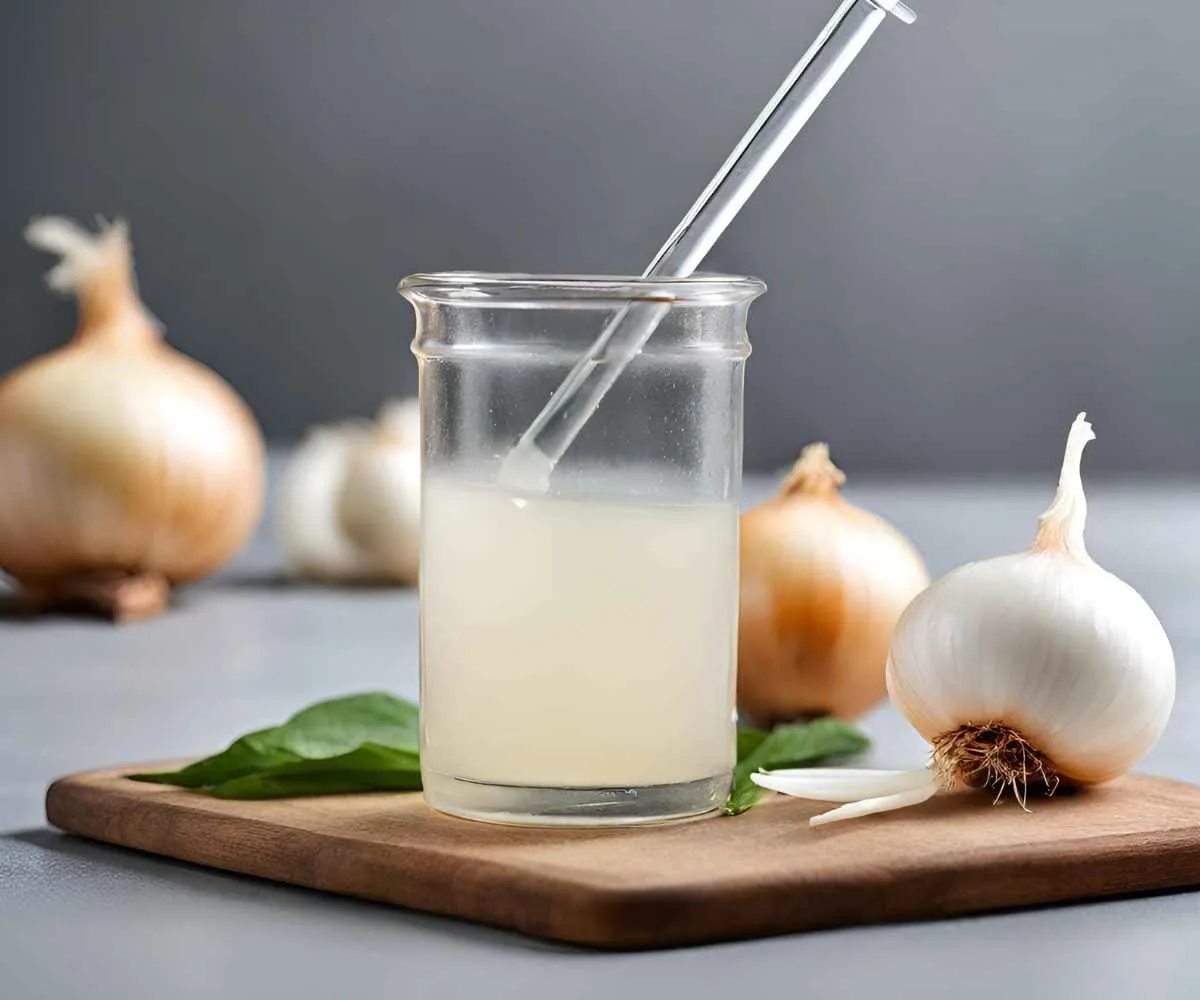
- Manuka Honey and Baking Soda Paste (mixed with a little coconut oil). This helps turn thick mucus into a thinner form, making it easier to clear a blocked nose. Apply a paste made of Manuka honey, baking soda, 1:1 and a bit of coconut oil to your nostrils with a cotton swab (one at a time). Swirl to coat a q-tip in this mixture and insert in one of the nostrils, lay down facing the opposite side down and wait for 15 minutes until you feel you need to blow your nose. Repeat with other side.
- Spicy Foods: Incorporating spicy elements like kimchi, sauces with hot peppers, horseradish and ginger into my diet helped clear the sinuses (temporarily). Plus the fermented food help replenish the gut flora with beneficial bacteria. This is best when used in conjuction with the other methods mentioned in this post.
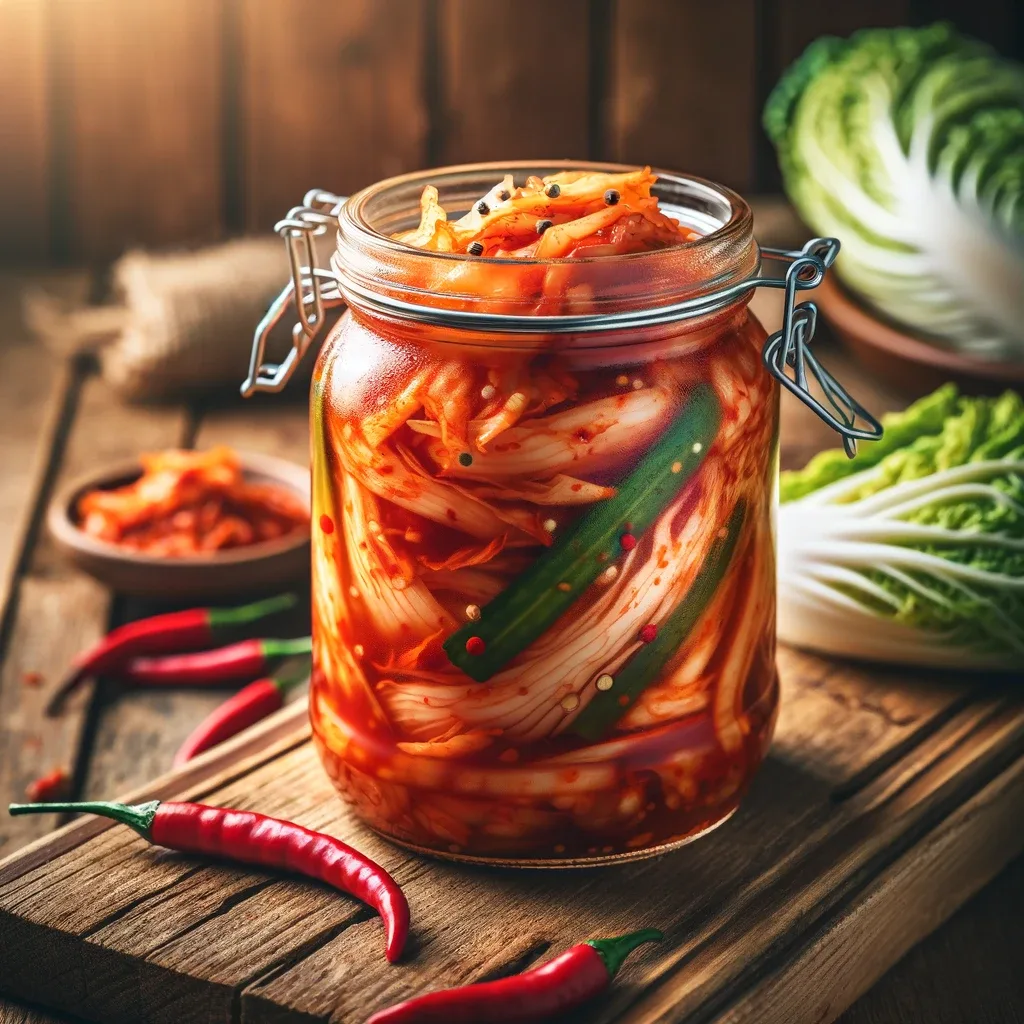
- Homeopathic Remedies: BHI Sinus Congestion Relief is a homeopatic formula that offeres a gentler approach (this can be used in conjuction with the above mentioned methods).
- Sinupret: It’s a herbal medicine widely used for the treatment of sinusitis in Germany. It contains a proprietary blend of several herbal extracts including Yellow Dock flower, Vervian flower, Elder flower, Cowslip flower, and Gentian root.
- Drinking of warm/hot fluids aids in alleviating nasal congestion. Hydration thins the mucus in your nasal passages, making it easier to expel, reducing congestion.
- Suggestions: ginger water, warm tea perfect for colds, flu bomb drink.

Step 3: Sinus Rinse to Eliminate Mucus
The final step involves a thorough sinus rinse, which can be performed 2-3 times daily, or more if necessary. You do this by leaning over the sink at a 45-degree angle, tilting your head and placing the tip of the device at the opening of your nostril. Then gently pour the solution into your nose. Sometimes making the sound “o” or “u” while rinsing helps open up smaller sinus openings.
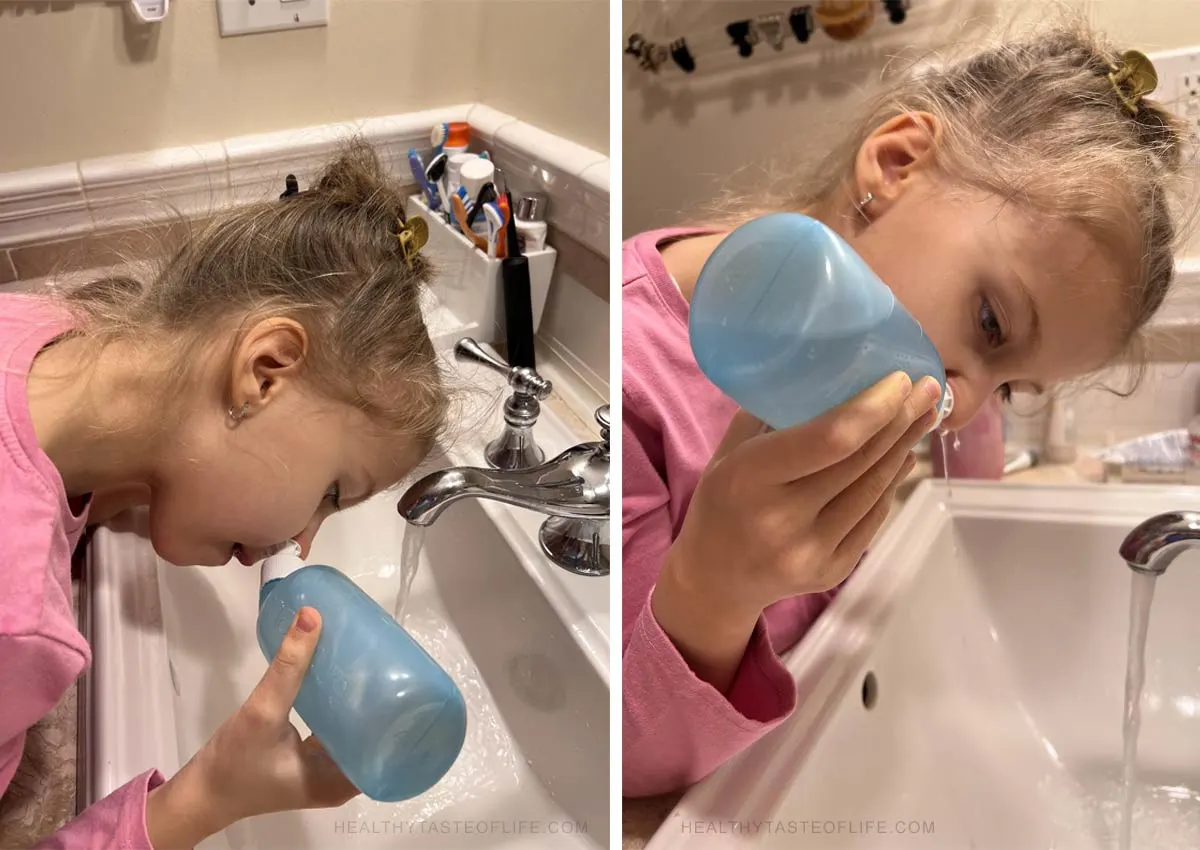
- Rinse Solution: Warm boiled water (240ml) mixed with sea salt(1/3 tsp) and baking soda (1/4 stp), 2-4 drops of Grapefruit Seed Extract (for its antibacterial and antifungal properties), xylitol (1/4 tsp) and lemon juice (1/3 teaspoon). The acid in the lemon breaks downs and flushes the mucus built up in the nasal cavities. Additionally I added in my rinsing water 5-6 drops of biocidin liquid formula – it cuts through biofilms and helps maintain the delicate balance of microorganisms.
- Once there was noticeable improvement, I reduced the use of antibacterial agents (GSE) and added a few drops of fermented juice from sauerkraut or kimchi to replenish good bacteria in the sinus flora.
Nasal Care: Post-rinse, I often used a nasal emollient like Ponaris oil and kept a humidifier nearby, especially at night, to soothe dryness.
Additional Tips
- Sleeping Posture: Keeping your head elevated while sleeping aids in keeping your sinuses clear.
- For immune support, consider Vitamin C, oregano oil, Lauricidin and Olive leaf extract (they are powerful antibacterial and antifungal natural remedies for sinusitis). Make sure to choose quality supplements without unnecessary added ingredients.
- For biofilm distruption, internally – NAC , Grapefruit Seed Extract and Biocidin LSF – they are well researched and are effective in clearing out the leftover matrix, minerals, and bacterial DNA of the pathogenic organisms, ensuring the colony doesn’t reassemble.
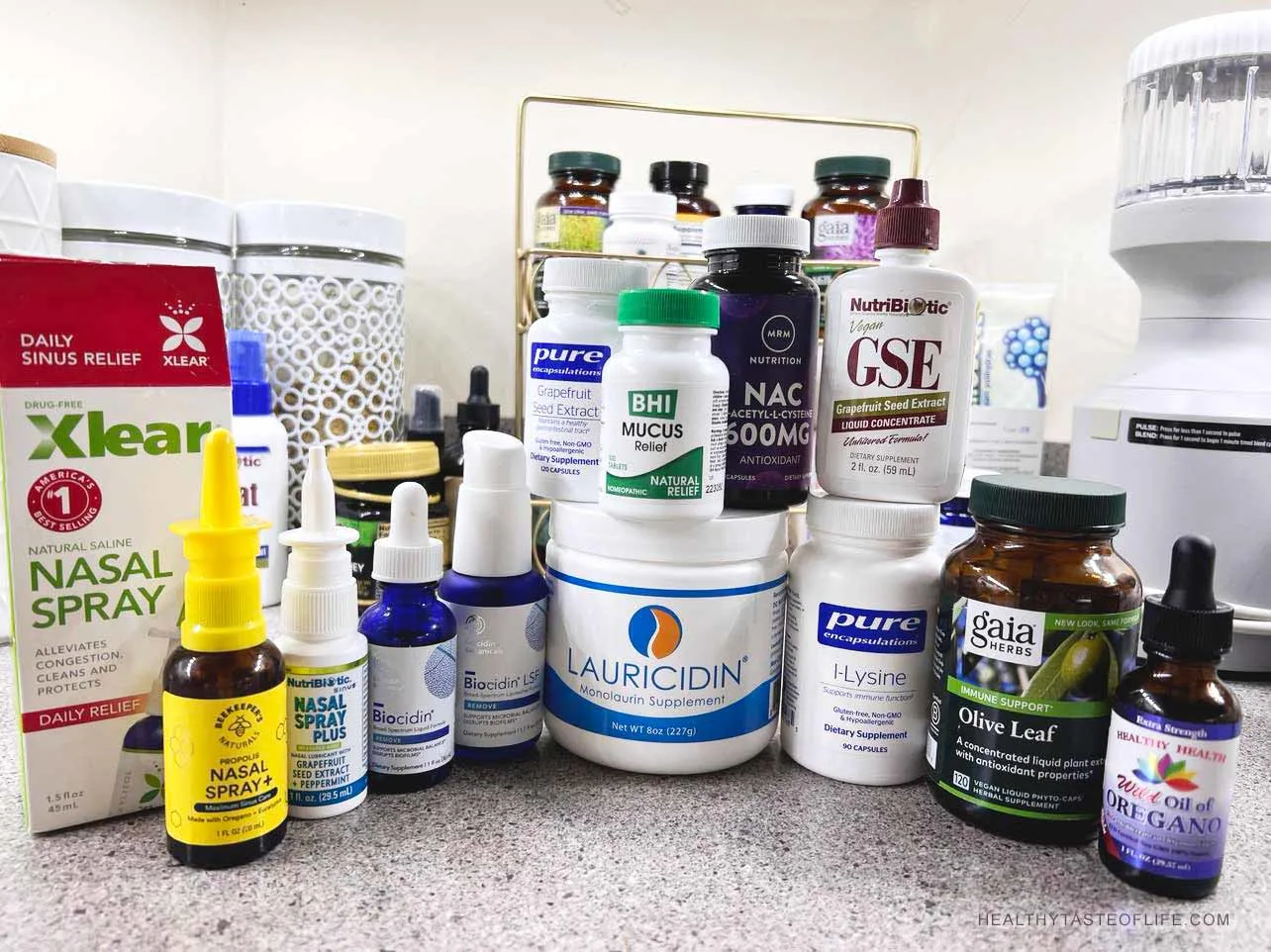
- Making a homemade immune boosting tonic is another great option if you can’t afford any supplements.
- Use an essential oil diffuser with eucalyptus, peppermint, and thyme oils while sleeping.
Related: How To Choose The Best High Quality Essential Oils
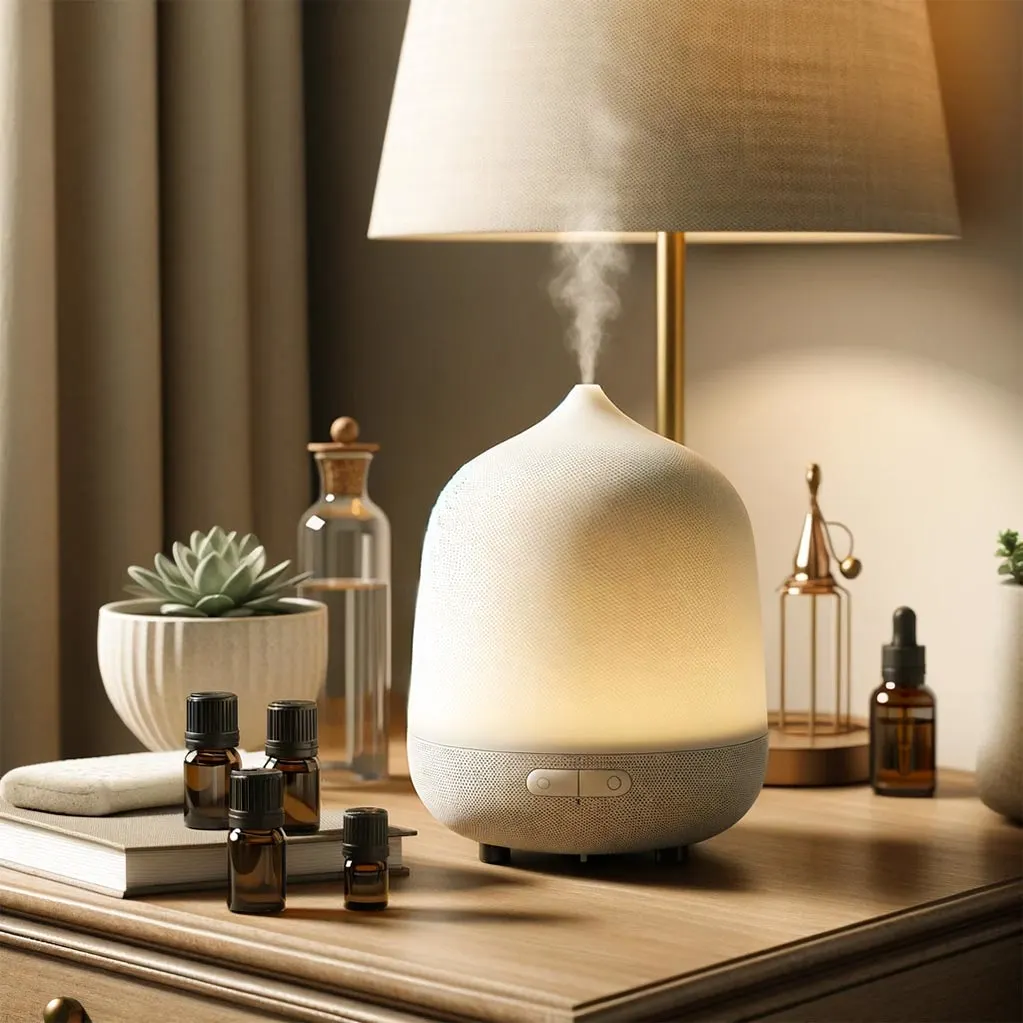
Word of Caution
Natural remedies for sinus congestion can be a safe and effective alternative to traditional medications. While this approach requires time and dedication, the relief it brings is well worth the effort. Remember, each person is unique, so what works for one may not work for another. Be patient and find the combination that works best for you.
Remember, this is not medical advice but a sharing of my own opinion. If you’re facing serious health issues accompanied with high fever and severe pain please use your judgement and consult a healthcare professional.
Disclaimer: The information, including but not limited to, text, graphics, images and other material contained on this website are for informational purposes only and should not be considered to be a specific diagnosis or treatment plan for any individual situation. Seek the direct advice of your own doctor if you have any questions or issues. Please refer to my full disclaimer for more info.

Mady
Friday 28th of June 2024
Hey there, You have done a fantastic job.